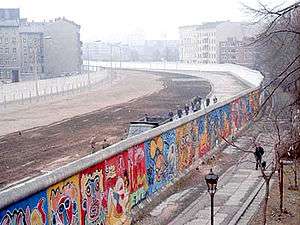Berlin Friedrichstraße station
Berlin Friedrichstraße | |
|---|---|
| Bf | |
 | |
| Location |
Friedrichstraße Mitte, Berlin Germany |
| Coordinates | 52°31′13″N 13°23′13″E / 52.52028°N 13.38694°ECoordinates: 52°31′13″N 13°23′13″E / 52.52028°N 13.38694°E |
| Line(s) | |
| Other information | |
| Station code | 0527 |
| DS100 code | BFRI |
| Category | 2 |
| Website | www.bahnhof.de |
Berlin Friedrichstraße ([bɛɐˈliːn ˈfʁiːdʁɪçˌʃtʁaːsə]) is a railway station in the German capital Berlin. It is located on the Friedrichstraße, a major north-south street in the Mitte district of Berlin, adjacent to the point where the street crosses the Spree river. Underneath the station is the U-Bahn station Friedrichstraße.[1]
Due to its central location in Berlin and its proximity to attractions such as the Unter den Linden boulevard, the Brandenburg Gate and the Reichstag, the station is a favorite destination for tourists. At the same time, it is the main junction for regional traffic in Berlin, measured by the number of passengers.[2]
During the Cold War, Friedrichstraße became famous for being a station that was located entirely in East Berlin, yet continued to be served by S-Bahn and U-Bahn trains from West Berlin as well as long distance trains from countries west of the Iron Curtain. The station also was a major border crossing between East and West Berlin.[3]
History
The initial station


engraving after the original architectural drawing published in 1885
In 1878, the first station was built after plans by Johannes Vollmer between the Friedrichstraße and the river Spree as part of the Berlin Stadtbahn construction. The architect was working on the neighbouring Hackescher Markt station at the same time. Just as the elevated viaduct the station is integrated into, the station rests on large arches built with masonry. The station had two platforms with two tracks each, covered by a large, curved train shed which rested on steel trusses of different length to cover the curvature of the viaduct underneath. The main entrance was on the northern side, the pick-up for horse carriages on the south side. Station opening was on 7 February 1882, as part of the ceremonial opening of the Berlin Stadtbahn. Long distance trains started on 15 May the same year.[4]
Extensions and remodel


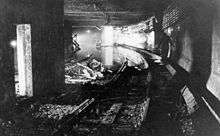
Because of the large amounts of traffic going through the station even before World War I, plans were made in 1914 to extend the station. There was a new, slightly elevated platform on the northern side for the S-Bahn, and the existing platforms had been made slightly narrower, leaving one platform for the S-Bahn, and two platforms for long distance trains. The steel-truss, double arched train shed was built between 1919 and 1925, featuring large glass fronts. On the northern side of the building, two entry halls in expressionist style were built, and the whole northern side was covered by a characteristic dark tile. The southern facade was only plastered until the last renovation in 1999, when it was also covered by tile.[5]
In 1923, the Friedrichstrasse underground station for line C (today's U6 and southeastern U7) was finished, creating the first part of the underground maze the station still has today.
At the beginning of the 1930s, construction began again at the Friedrichstrasse station, as the North-South tunnel of the S-Bahn was driven under the station. A long pedestrian tunnel connecting to the underground station of the same name Berlin U-Bahn was also driven under the northern end of the station, and that underground station received the characteristic yellow tile still featured today.[6] On 27 July 1936, just before the 1936 Summer Olympics, the underground S-Bahn station was opened.[6]
After the "Kristallnacht", starting 1 December 1938, thousands of Jewish children started from or passed through the station to leave Germany as part of the Refugee Children Movement.
The station was bombed by Polish sabotage and diversionary squad "Zagra-lin" in early 1943, with 14 people dead and 27 wounded.[7]
It escaped major damage during the bombing of Berlin in World War II. U-Bahn and S-Bahn ceased operations on 23 and 25 April 1945, respectively, due to shortage of electricity. During the morning of 2 May 1945, the day Berlin capitulated, a detonation of the North-South tunnel under the Landwehrkanal, caused the flooding of the tunnel, including Friedrichstraße's belowground S-Bahn station along with a large part of the Berlin underground system via the connecting tunnel between the S-Bahn and the Berlin U-Bahn at their respective Friedrichstrasse stations.[8]
Reconstruction started in 1945. Trains first returned to the facilities above ground. By the end of May and early June 1945 the BVG, the operator of Berlin's U-Bahn, had sealed up the pedestrian tunnel between tunnel S-Bahn and U-Bahn station to stop water flooding into the underground tunnel. Reichsbahn, the operator of the S-Bahn, had declared that it lacked the means to close the tunnel leaks. On 4 June BVG started the drainage of its underground system. On 12 July the underground reopened its Friedrichstraße station for two one-track shuttle operations, one from north and one from south meeting there, regular two-track traffic restarted on since 5 December 1945.[9] Reichsbahn drained its North-South tunnel only later and reopened below-ground S-Bahn service on 2 June 1946. On 1 December the same year North-South tunnel and Friedrichstraße below-ground S-Bahn station shut again for an extensive refurbishment which lasted until 16 October 1947, when the North-South tunnel was fully operational again.
Border crossing during the cold war
_en.svg.png)

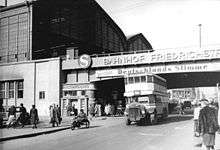


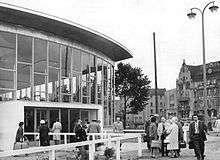


During the onset of the cold war and its tensions between the Western and the Soviet occupied sectors of Berlin, the Friedrichstrasse station played an important role for citizens of Berlin to reach their friends and relatives in other sectors of Berlin. At the end of 1946, the Soviet Military Administration in Germany had created an East German border police tasked with preventing Republikflucht (escape from the East German republic). With the erection of the Inner German border in 1952, East Germany was to a large degree sealed off from the west. However, Berlin, and in particular the public transport system that criss-crossed between the western Allied and Soviet sectors was still a hole in that iron curtain. Accordingly, Berlin became the main route by which East Germans left for the West. The 3.5 million East Germans that had left by 1961 totaled approximately 20% of the entire East German population,[10] many using the Friedrichstrasse station with its bustling traffic as the starting point for their escape. During the Uprising of 1953 in East Germany and East Berlin, the Reichsbahn national railway stopped S-Bahn transport between 17 June and 9 July 1953.
When the East German government erected the Berlin Wall on 13 August 1961, it also severed the U-Bahn, S-Bahn and long distance train connections that criss-crossed through Berlin. The district of Berlin Mitte, where the Friedrichstrasse station is located, was surrounded in the northerly, westerly and southerly directions by Western Sectors: For the S-Bahn at the Friedrichstrasse station, the next station to the west was across the wall in West Berlin, to the north were three more stops in the Soviet sector and only two to the south. The situation was similar for the U6 metro underneath the Friedrichstrasse, which had three stations to the north and two stations to the south before crossing the wall.
Therefore, despite their being wholly located in East Berlin, all of the station's underground facilities, namely the S-Bahn platform of the North-South tunnel and the underground station, were only accessible for passengers from the western sectors as a transfer station, or to access the border crossing at the ground level.
The facilities above ground, on the arches of the Stadtbahn, were separated along the platforms:[11]
- Platform A was used for long distance trains. This included the so-called Interzonenzüge, trains running non-stop from Berlin through East German territory to West Germany. For those trains the Friedrichstrasse station was a terminus. This platform was also a stop for trains with international destinations such as Copenhagen, Stockholm (using the ferry connection between Sassnitz and Trelleborg) or the legendary Paris - Moscow express. The latter could not be boarded by East German passengers at this station; they could only board the train at its next stop Berlin Ostbahnhof.
- Platform B became the terminus for the Stadtbahn arriving from West Berlin to and from Wannsee and Staaken. Passengers were able to transfer to the underground lines of the S-Bahn and the U-Bahn, or to long distance trains without entering East Germany.
- Platform C in the smaller train shed on the north side was used by traffic going to East Berlin and East Germany, which became now the terminus for the Stadtbahn lines to Erkner, Königs Wusterhausen, Strausberg Nord, Ahrensfelde, Wartenberg, and to the Berlin-Schönefeld airport.
Between the platforms B and C was a metal-glass barrier that practically fulfilled the same function as the Berlin wall: East German border troops had separated the station into two completely isolated areas, both fully under armed control, the one for people within East Berlin and the other for transit travellers, persons switching between the different westbound train lines and the few Easterners with a hard-to-obtain exit visa, all within one station building with a maze of connecting hallways, barriers, numerous cameras, armed guards with sniffer dogs, plain-clothes agents, and a loggia under the roof for surveillance by armed border patrol and Stasi officers.[12]
Tracks between the western and eastern systems were, aside from the long distance tracks, completely separated. S-Bahn trains using the heavily guarded passing track west of platform C required permission from the commander of the border guard detail. An exchange of rolling stock between the divided S-Bahn segments of Berlin was only possible via the long distance tracks on platform A. These tracks were equipped with derailers to prevent escape attempts.
At the ground level, between the elevated and the underground part of the station, were the facilities for crossing into East Berlin. This included three individual passport checks, customs control, waiting rooms (since the crossing could take anywhere from 15 minutes to several hours), interrogation rooms, holding cells, offices to register and record people crossing the border, and a counter for visa fees and the (mandatory) currency exchange.[12]
Due to its location in central Berlin, with its many shops, offices, official buildings, embassies, hotels, as well as cultural and entertainment (Friedrichstadtpalast, Metropol theatre house, opera house, Museum Island), as well as being a border crossing, traffic in the station was enormous. In the beginning after the wall had been built, both the eastbound and the westbound border traffic was controlled on ground level. These rather constrained circumstances, compounded by the traffic in and around the station, led to the construction of a building on the square north of the station, which was connected to the main station. This new building was used for westbound border crossings, with separate checkpoints for citizens of West Berlin, citizens of West Germany, foreigners and diplomats, transit travellers, and East German citizens. On the door was a guard station to separate people permitted to cross the border from those ineligible, leading to many tearful goodbyes in front of the building. This gave the building the moniker Tränenpalast ("Palace of Tears").[6][11][12]
On the southern side of the station building was the so-called "service entry" (Diensteingang) for personnel of the Deutsche Reichsbahn (the East German national railways). This entry led through its own control room and then, via several corridors, to a door on the ground floor of the "western" side. The entry was used to infiltrate and exfiltrate agents of the East German intelligence service, and to allow members of the West German communist party and West Berlin socialist party to pass without being checked or recorded.[13] This secret pathway between the two cold war fronts was also the escape route for some members of the West German terror organization Red Army Faction to avoid arrest in West Germany. On 7 July 1976 the officially-wanted Movement 2 June members Inge Viett, Monika Berberich, Gabrielle Rollnick, and Juliane Plambeck escaped following their escape from prison, and on 27 May 1978 Till Meyer, escaped into East Germany via Friedrichstrasse station, though they did not stay there. Viett later escaped to East Germany again and stayed there until the fall of the Berlin Wall.[14][15] In opposite direction, on January 18, 1979, the East German double agent Werner Stiller used this path to escape to the West.[13][16]
The railway station held another attraction during the Cold War. The ground level and the underground platforms on the "western" side of the station had so called Intershops, created specifically for travellers from West Berlin who did not want to pass through the East German border controls.[12] Initially just mobile trollies offering alcohol and tobacco, they were soon shops integrated into the station offering food, alcohol, tobacco, books, toys, jewellery, cosmetics, gift items, and more. One could disembark from the U-Bahn, make a purchase, and then get back on the next train and go back to West Berlin, all without going through East German border controls. Purchases could be made with any fully convertible currency, such as U.S. dollars, French francs, pounds sterling, Swiss francs, and especially the West German Deutschmark. The merchandise was offered duty-free, which made especially the alcohol and tobacco products particularly attractive to passengers from West Berlin. This was also known to the West Berlin customs agency, which sometimes checked travellers coming from the Friedrichstrasse at their first station in West Berlin.[12]
Between 1985 and 1987, a minor renovation of the train shed took place, where the middle wooden roofing section was replaced with glass. The lighting was replaced and the metal parts of the shed were painted.
After the fall of the Berlin Wall to the present


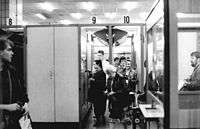
_9.8.2009.jpg)



Immediately after the fall of the Berlin Wall, the traffic for the S-Bahn in Berlin as well as long distance train traffic to and from Berlin increased dramatically.[6][17] At first, to immediately ease travel between East- and West-Berlin, the walls and barriers that were built to separate the station were removed. By July 1990, the severed tracks on platform C were reconnected, and after almost 29 years, there was again uninterrupted traffic on the Stadtbahn viaduct line from Berlin Alexanderplatz station to Berlin Zoo station. Very little maintenance had been done to the station during the East German years, and especially the underground section looked like a relic from a different time.
Between August 1991 and February 1992, the North-South S-Bahn tunnel including the underground section of the Friedrichstrasse station was closed for a complete overhaul. Between October 1995 and September 1999, the ground level and the raised level on the Stadtbahn viaduct was completely renovated, costing the Deutsche Bahn a total of 220 Million Deutschmarks. The façade of the building was covered with terra cotta clinker bricks as the original building had,[18] this time including the southern face of the building. An additional tunnel for traffic to the U-Bahn U6 was driven under the station, and elevators were added between the floors. The 5,200 square metres (56,000 sq ft) ground floor was converted into a shopping area with 50 businesses. Since reopening, regional trains now stop on platform A and B.
Beginning in 2002, the North-South S-Bahn tunnel was again renovated, which removed the last traces of East Germany from Friedrichstrasse station - the green tiles covering the walls.
On 30 November 2008, a memorial was unveiled for the 10,000 Jewish children saved by the Refugee Children Movement that started their journey at this station. Frank Meisler, the sculptor of the memorial, was himself saved by one of the trains bound for Liverpool and London.[19]
Train services
The station is served by the following service(s):[20]
- Regional services RE 1 Magdeburg – Brandenburg – Potsdam – Berlin – Erkner – Fürstenwalde – Frankfurt (Oder) (– Cottbus)
- Regional services RE 2 Wismar – Schwerin – Wittenberge – Nauen – Berlin – Königs Wusterhausen – Lübben – Cottbus
- Regional services RE 7 Dessau – Bad Belzig – Michendorf – Berlin – Berlin-Schönefeld Airport – Wünsdorf-Waldstadt
- Local services RB 14 Nauen – Falkensee – Berlin – Berlin-Schönefeld Airport
- Peak hour services RB 21 Berlin – Potsdam – Golm – Wustermark
- Peak hour services RB 22 Berlin – Potsdam – Golm – Saarmund – Berlin-Schönefeld Airport - Königs Wusterhausen
- Berlin S-Bahn services
 Oranienburg – Wittenau – Gesundbrunnen – Friedrichstraße – Potsdamer Platz – Schöneberg – Steglitz – Wannsee
Oranienburg – Wittenau – Gesundbrunnen – Friedrichstraße – Potsdamer Platz – Schöneberg – Steglitz – Wannsee - Berlin S-Bahn services
 Bernau – Karow – Pankow – Gesundbrunnen – Friedrichstraße – Potsdamer Platz – Sudkreuz – Blankenfelde
Bernau – Karow – Pankow – Gesundbrunnen – Friedrichstraße – Potsdamer Platz – Sudkreuz – Blankenfelde - Berlin S-Bahn services
 Hennigsdorf – Tegel – Gesundbrunnen – Friedrichstraße – Potsdamer Platz – Sudkreuz – Lichterfelde – Teltow
Hennigsdorf – Tegel – Gesundbrunnen – Friedrichstraße – Potsdamer Platz – Sudkreuz – Lichterfelde – Teltow - Berlin S-Bahn services
 Spandau – Westkreuz – Hauptbahnhof – Alexanderplatz – Ostbahnhof – Lichtenberg – Strausberg Nord
Spandau – Westkreuz – Hauptbahnhof – Alexanderplatz – Ostbahnhof – Lichtenberg – Strausberg Nord - Berlin S-Bahn services
 Potsdam – Wannsee – Westkreuz – Hauptbahnhof – Alexanderplatz – Ostbahnhof – Lichtenberg – Ahrensfelde
Potsdam – Wannsee – Westkreuz – Hauptbahnhof – Alexanderplatz – Ostbahnhof – Lichtenberg – Ahrensfelde - Berlin S-Bahn services
 Spandau – Westkreuz – Hauptbahnhof – Alexanderplatz – Ostbahnhof – Lichtenberg – Wartenberg
Spandau – Westkreuz – Hauptbahnhof – Alexanderplatz – Ostbahnhof – Lichtenberg – Wartenberg
| Preceding station | Deutsche Bahn | Following station | ||
|---|---|---|---|---|
| RE 1 | ||||
toward Dessau Hbf | RE 7 | toward Wünsdorf-Waldstadt |
||
toward Nauen | RB 14 | toward Berlin Schönefeld Flughafen |
||
toward Wustermark | RB 21 | Terminus | ||
toward Königs Wusterhausen | RB 22 | Terminus | ||
| Preceding station | Ostdeutsche Eisenbahn | Following station | ||
toward Wismar | RE 2 | toward Cottbus |
||
| Preceding station | Berlin S-Bahn | Following station | ||
toward Wannsee | S1 | toward Oranienburg |
||
toward Blankenfelde | S2 | toward Bernau |
||
toward Teltow Stadt | S25 | toward Hennigsdorf |
||
toward Spandau | S5 | toward Strausberg Nord |
||
toward Potsdam Hbf | S7 | toward Ahrensfelde |
||
toward Spandau | S75 | toward Wartenberg |
||
| Preceding station | Berlin U-Bahn | Following station | ||
towards Alt-Tegel | U6 | towards Alt-Mariendorf |
S-Bahn and regional trains stop at the upper platforms A - C on the Berlin Stadtbahn viaduct, elevated above city streets. This upper level of the station is enclosed by two train shed halls. The smaller shed on the north side is used for the S-Bahn, the larger on the south for regional trains. Platform D is a station on the North-South tunnel of the S-Bahn, located underground approximately aligned with the eastern bank of the Spree river.
The underground station for the U6 line is located at the eastern end of the station, directly under the Friedrichstraße. In addition, the south side of the station serves as station and terminus for a number of trams and buses of the Berlin transportation company.
Shops
Since the remodel in 1999, the station houses numerous shops, boutiques and restaurants, making the station blend in with the neighbouring Friedrichstrasse shopping area. In addition, the station houses a Berlin S-Bahn customer center, and a Deutsche Bahn travel center. On the plaza on the south side of the station is a large Taxi stand, and the station is also connected to the Berlin bus and tram system.
The former Tränenpalast was used as a club and stage for various performances, such as readings, concerts, and cabaret until 2006.[21] Since September 2011, the building has become a branch museum of the Bonn-based Haus der Geschichte (House of History) and hosts a permanent exhibition devoted to the history of crossing the inner-German border, with particular emphasis on what it was like to cross between East and West Berlin.
In popular culture
There are numerous movies that include scenes filmed at the Friedrichstrasse station:
- In the Bourne Supremacy, Jason Bourne escapes the police by leaping off the bridge in front of the station onto a boat below.
- In The Keys to the House, the windows of the father and son's hotel room face the station at platform level.
- The movie The Legend of Rita has numerous scenes where the Red Army Faction terrorists use the station to escape to East Berlin.
In addition, the East German spy Werner Stiller describes his escape through the station in his memoirs Beyond the Wall.
In Mr Norris Changes Trains, novelist Christopher Isherwood has William Bradshaw eating ham and eggs with Arthur Norris at the first class restaurant of the station.
In Call of Duty: World at War, the station is used as a means of escape for the Red Army during the Battle of Berlin.
In the novel No Man's Land by Michael Califra, the story's narrator, a U.S. expatriate named Richard who lives in West Berlin, is detained in the station after spending the night with his East German girlfriend, Traudi Franzke.
References
| Wikimedia Commons has media related to Bahnhof Berlin Friedrichstraße. |
- ↑ Info Friedrichstrasse station
- ↑ Hauptbahnhof bewährt sich Archived February 27, 2007, at the Wayback Machine. in Der Tagesspiegel Dezember 24, 2006 (German)
- ↑ Jennings, Ken (May 21, 2012). "Friedrichstrasse Station: The Cold War's Three-Dimensional Border". The Daily Traveler. Conde Nast Traveler.
- ↑ Friedrichstrasse.de historie
- ↑ "Tragedy, trauma and transformation: tracking Friedrichstrasse station's past". secretcitytravel.com. Retrieved 24 August 2014.
- 1 2 3 4 Stadtschnellbahn Berlin (German)
- ↑ The Polish underground state:a guide to the underground, 1939-1945 Stefan Korboński page 88 1981
- ↑ see History_of_the_Berlin_U-Bahn#World_War_II
- ↑ Cf. U-Bahn-Chronik.
- ↑ Dowty, Alan (1989), Closed Borders: The Contemporary Assault on Freedom of Movement, Yale University Press, ISBN 0-300-04498-4
- 1 2 Former border station Friedrichstrasse (German)
- 1 2 3 4 5 Chronicle of the Berlin Wall (German)
- 1 2 Werner Stiller: Beyond the Wall: Memoirs of an East and West German Spy, ISBN 978-0-02-881007-2, pg. 228
- ↑ Berliner Zeitung, 22 July 2008 (German)
- ↑ Im Sumpf der RAF (German)
- ↑ Thomas Wagner: If it had not been for 15 minutes, chapter 10 Archived March 3, 2009, at the Wayback Machine.
- ↑ Chronicle of traffic development in East Berlin (German)
- ↑ Eine Hülle aus lila Klinkern (German)
- ↑ Berliner Morgenpost, 1 December 2008 (German)
- ↑ Timetables for Berlin Friedrichstraße (German)
- ↑ Official Tränenpalast web site (German)
External links
- Technische Universität Berlin Architekturmuseum, architectural plans
- bildindex der Kunst und Architektur (the train shed under construction 1881)
- bildindex der Kunst und Architektur (Friedrichstraße station prior to the extension 1914-25)
- Station information (S-Bahn) (German)
- The Berlin S-Bahn at The Locomotive & Carriage Institution
